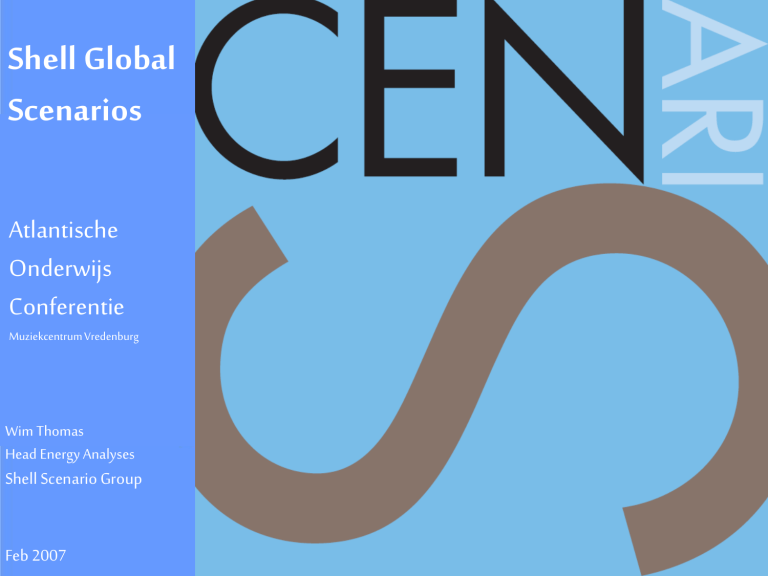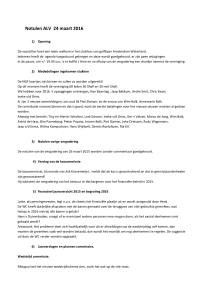
Shell Global
Scenarios
Atlantische
Onderwijs
Conferentie
Muziekcentrum Vredenburg
Wim Thomas
Head Energy Analyses
Shell Scenario Group
Feb 2007
The Shell Global Scenarios
The companies in which Royal Dutch Petroleum Company and The “Shell” Transport and Trading Company, p.l.c. directly or indirectly
own investments are separate and distinct entities. The expressions “Royal Dutch/Shell Group” and “Group” are used to refer to the
companies of the Royal Dutch/Shell Group as a whole. The words “Shell”, “we”, “us” and “our” are used in some places to refer to the
Group and in others to an individual Shell company or companies where no particular purpose is served by identifying the specific
company or companies.
The information contained in this presentation is, to the best of our knowledge, true and accurate although the forward looking
statements herein are by their nature subject to risk factors which may affect the outcome of the matters covered. None of Shell
International Limited, its affiliates and their respective officers, employees and agents represents the accuracy or completeness of the
information set forth herein and none of the foregoing shall be liable for any loss, cost, expense or damage (whether arising from
negligence or otherwise) relating to the use of such information. Permission should be sought before any part of this presentation is
reproduced, stored or transmitted by any means. Trilemmap is a Shell trademark.
© Shell International Limited, 2005
2
“Het ziet er niet rooskleurig uit, heren…..Het wereld klimaat is aan het
veranderen, de zoogdieren zijn in opkomst, en we hebben allemaal een
stel hersens zo groot als een walnoot”
Wat zijn scenarios en waarvoor worden ze
gebruikt?
Het naar voren brengen van aannames en onzekerheden beter leren
begrijpen
•
•
•
•
De keuzes die we vandaag maken zijn afhankelijk van de aannames
die we maken betreffende de toekomst
4
Geen projecties,
voorspellingen of persoonlijke
voorkeuren
Plausibele alternatieve
toekomsten
‘Wat als’ vragen, niet zozeer
antwoorden
Delen en vergroten van
perspectieven
•
Vergroot begrip en creëer
overeenstemming
•
Betere strategieën
Shell Global Scenarios 2005
De tweeledige crisis van ‘Veiligheid’ en
‘Vertrouwen’
5
1990s:
Gehoor geven aan mondiale krachten
Liberalisatie
6
‘There Is No Alternative’
Shell Global Scenarios in de 1990 jaren:
“TINA” en de dilemma's van globalisatie
“Business
Class”
“Prism”
7
2001 – 2004: De tweeledige crisis van
‘Veiligheid’ en ‘Vertrouwen’
8
De Staat reageert …
9
De drie Global Scenarios
3 krachten en 3 doelstellingen: een “Trilemma”
10
US & CHINA
De drie Global Scenarios
Gemeenschappelijke trends
11
Low Trust Globalisation
12
Sterke Staten
13
Low Trust Globalisation
• Sterke Staten. Globalisatie op eigen
termen
• Veiligheid door diepgaand onderzoek
en controle
• Veel regulatie door overheden
• Een legalistisch, ‘toon het mij aan’
wereld
• Economie onder potentieel
• Energiezekerheid door diversiteit van
aanbod
• OPEC standvastig. Hoge olie prijzen
14
Open Doors
15
Vertrouwen
16
Open Doors
• Vertrouwen is hersteld – voorzorgsmaatregelen
• Staten handelen via stimulatiebeleid en soft
power
• Een pragmatische ‘ken mij’ wereld
• Accommoderende internationale instituties
• Hoge economische groei en sterke globalisatie
• Energiezekerheid door middel van open markten,
vrije handel
• Groene energie, maar via marktwerking
• Hoge, fluctuerende, maar “betaalbare” olie prijzen
17
Flags
18
Weestand tegen Amerikaanse hegemonie
“In the Balkans and in the Middle East
alike, the United States has failed to exert
its hegemonic clout effectively, not for want
of will or effort but for want of real power.”
Immanuel Wallerstein
Yale University
19
Flags
• Dogmatische, ‘volg mij’ wereld
• Concurrerende claims van verschillende
gemeenschappen
• Veiligheid door beperken van toegang
• Populistisch en nationalistisch beleid
• Lage economische groei in een
gefragmenteerde wereld
• Energiezekerheid op eigen kracht
• Wereld van nationale energiebedrijven
• OPEC prijs doel onhaalbaar
20
GS05
Een drie lagen structuur
21
GS05: Individuele landen …
Overal is niet hetzelfde …
Efficiency
Low Trust
Globalisation
Open Doors
Aspirationa
l EU
US
India
Russi
Chin
a
a
France
ME
Security
22
Flags
Social
cohesion
23
Groei in energievraag
hoofdzakelijk in opkomende economieën
mboe/d
400
300
200
Ontwikkelende landen
100
Ontwikkelde landen
0
2000
24
2025 low
2025 high
Marktaandeel van primaire energiesoorten
2005
2025
40%
40%
35%
35%
30%
30%
25%
25%
20%
20%
15%
15%
10%
10%
5%
5%
0%
0%
Oil
Gas
Coal
Nuclear
Renewables
LTG
25
Open Doors
Oil
Flags
Gas
Coal
Nuclear
Renewables
Toenemende afhankelijkheid van handel
Handelsstromen 2010 vergeleken met 1997
% verandering (mln bbl/d)
-21%
(-0.7)
+53%
(+0.55)
(+4.2)
-19%
(- 0.09)
-15%
+25%
+269%
+20%
(+0.20)
70%
+60%
(+3.7)
(-2.60)
(- 0.15)
(-0.30)
(+0.88)
Importen van
MO
West Afrika
NW-Europa
Canada
ZO Asie
VSR
Latijns America
26
Only main trade flows displayed
-26%
+30%
(+ 0.50)
+670%
(+2.9 )
Koolstof
Verontrustende CO2 Trends
Hoge economische groei maakt een vermindering van uitstoot van broeikasgassen een grote uitdaging
Bij 2025, uitstootlimiterende technologie heeft nog weinig effect/toepassing
14
1000
13
12
550
11
10
9
8
450 ppmv
7
6
2005
OD
27
2015
LTG
2025
Flags
2035
De kool-waterstof industrie
28
Potentieel genoeg duurzame energie
voor 10 mrd mensen …
Energy potential (EJ/year)
1,400
1,200
1,000
800
600
400
200
0
29
All countries
Japan
Oceania
South East Asia
East asia
South Asia
Middle East
Former USSR
Eastern Europe
OECD Europe
Southern Africa
Eastern Africa
Western Africa
Northern Africa
South America
Central America
USA
Canada
… maar het mitigeren van onbetrouwbaarheid en omzetting naar vloeibare
brandstoffen is nog een grote technologische uitdaging.
“Fundamental questions that face us all”
Energiezekerheid
Klimaatverandering
land
Wereld
Afhankelijkheid
30
Duurzaamheid
Shell
Global
Scenari
os 2005
www.shell.co
m/scenarios
Wim Thomas
Head Energy Analyses
Shell Scenario
Group
The Global Scenarios 2005
Back-up
32
New energy architectures
New strategic challenges
New Actors
SCO
New rules and
Institutions
33
New industry structure
&
roll for national companies
CO2-stabilisation – Sure, but how?
Gt CO2 / yr
8
7
6
2 Gt
CO2-Sequestration in Power
1 Gt
Renewable Power
1 Gt
Nuclear
1 Gt
Higher generation efficiency
1 Gt
2G Biofuels + Hybrid
1 Gt
Efficiency + CCS
1 Gt
Higher efficiency in
electricity end-use
5
4
3
2
1
0
34
IEA WEO 2006
WBCSD: Pathways to 2050
Energy intensity has to half
400
2002
2050
Linear (2050)
Linear (2002)
Energy per capita, GJ
350
300
250
200
150
100
50
0
$0
35
$20
$40
$60
GDP per capita, US$ 1995 (ppp)
WBCSD: Pathways to 2050
Carbon intensity has half as well
400
USA & Canada
2002
350
2050
Energy per capita, GJ
300
250
200
150
100
EU-25
CO2 per energy
unit used, t / TJ
50
China
0
$0
36
$10 $20 $30 $40 $50 $60
GDP per capita, 1,000 US$ 1995 (ppp)
$70
Constraint on World Nuclear Powergen
(GWh)
3,500,000
3,000,000
2,500,000
2,000,000
1,500,000
1,000,000
500,000
0
2005
10
15
20
25
30
35
40
45
50
Assuming a plant life can be extended from 45 to 60 years, Load factor of 85%, a
build up of EPC capacity to a maximum rate of 30 p.a. and limited technology transfer
37
Potentially sufficient renewable
resources for 10 bln people …
38
… but intermittency and conversion into liquid fuels will
prove a technological challenge.
Low Trust Globalisation
World Energy Demand
•
World Energy Demand
LTG
mln boe/d
400
300
200
100
0
2000.0
Oil
39
Gas
2005.0
2010.0
2015.0
Coal
Hydro
Nuclear
2020.0
2025.0
Renewables
•
•
•
•
Total Energy demand grows
with 2.3% p.a.
Oil grows 1.6% p.a.
Gas grows 3.1% p.a.
Coal grows 2% p.a.
Strong growth in Renewables
with 10% p.a.
Open Doors
World Energy Demand
•
World Energy Demand
Open Doors
400
300
200
100
0
2000
Oil
40
Gas
2005
2010
Coal
Hydro
2015
Nuclear
2020
2025
Renewables
•
•
•
•
•
Total energy demand grows
with 2.7% p.a.
Oil grows 1.9% p.a.
Gas grows 3.5% p.a.
Coal grows 2.4% p.a.
Nuclear grows 1.4% p.a.
Renewables grow 11% p.a.
Flags
World Energy Demand
•
World Energy Demand
Flags
400
300
200
100
0
2000
Oil
41
Gas
2005
Coal
2010
2015
Hydro
Nuclear
2020
2025
Renewables
•
•
•
•
Total energy demand grows
with 1.6% p.a.
Oil at 0.8%
Gas at 1.7%
Coal at 1.2%
Renewables at 11%
Rapidly increasing co-operation between NOCs
WTI
CNPC/Gazprom
$70
Access
Resource/Market
CNPC/Rosneft
Gazprom/KOGAS
Aramco/IOC
India/Azerbaijan
CNPC/Egypt
Gazprom/ONGC
Rosneft/Sinopec
CNPC/Iran
OIL/Libya
PTT/Iran*
CNPC/Sonatrach
PDVSA/CNPC
ONGC/CUPET
CNPC/Yukos
Petrobras/PDVSA
ONGC/Pemex
$65
$60
$55
$50
Rosneft/KNOC Statoil/KazMunaiGaz ONGC/KazMunaiGaz
Sinopec/Aramco
Statoil/Petropars*
Petronas/NIOC*
Statoil/Sonatrach ONGC/Petro-Ecuador
Sinopec/Gabon
Rosneft/CNPC
Statoil/Pertamina
CNOOC/Petrobras
CNPC/Statoil
Gazprom/KOGAS
PDVSA/ENI
Gazprom/Pemex
Hydro/ONGC
$45
Technical
Co-op
$40
Gazprom/Statoil/
Sinopec/Petrobras
Hydro
Petrobras/ENAP
CNPC/PDVSA
Statoil/Kazakhstan
CNPC/KMG
Statoil/Gazprom
Statoil/NIOC
Statoil/NIOC
Statoil/NNPC
Statoil/Petrobras
Statoil/Rosneft
ONGC/Hydro
$35
ONGC/Petrobras
ONGC/SOCAR
$30
Petrobras/CNPC ONGC/Petro-Ecuador
$25
2000
42
2001
2002
2003
2004
2005
2006
Biofuels
Biofuels 1st Generation
kt/yr
2500
Bio-components
(Ethanol, FAME)
Biofuels 2nd Generation
Sunflower
Rape seed
Soja
Food
Bio-Ester
Plants
waste
2000
Conversion
Biomass-to-Liquids
1500
Diesel
Diesel
1000
500
0
Shell Exxon BP ChevronTOTAL
Mobil
Source: Shell, EUCAR/JRC/CONCAWE
43
Plant
swas
te
Wheat
Corn
Sucre
cane
Food
Enzymati
c
Hydrolyse
Cellulose
/
s
Ethanol
Bio
ethanol
Petrol
Petrol
Pro: higher agricultural yields, more CO2saving by using organic waste
Synthetic fuels
GT
L
Natural
gas
Biomass
Coal
•
•
•
gasificatio
n
BT
L
gasification
Syn gas
CT
L
gasificatio
n
Clear fluids, clean combustion
High octane, almost sulpher free
Low air polution
Fischer-Tropsch
Process
Synthetic fuels enables
‘designer’ developments:
• Lower emissions
• Higher efficiencies
• Better engine performance
• Lower noise
44
Identical Products
Carbon Capture & Storage (CCS) –
ZeroGEN Project, Australia
Coal Gasification,
Rockhampton
Queensland
Rockhampton
200 km CO2 Pipeline
Brisbane
CO2-Savings in North
Dennison
Storage ca. 2.000 m below ground
45
Energy policy challenges
46
Wie is hier de held?
47
Belangrijke kwesties en hun drijfveren
Gebeurtenissen
Trends and Patronen
Drijfveren
Technologie Wetgeving
Demografie
Ecologie
Politiek
Financiën Grondstoffen
Regulatie
IT
Fysica
48
Beleid
Cultuur
Mentale modellen
49
Het begrijpen van de wisselwerking
Economie
Politiek
Maatschappij
Milieu
50
Technologie












